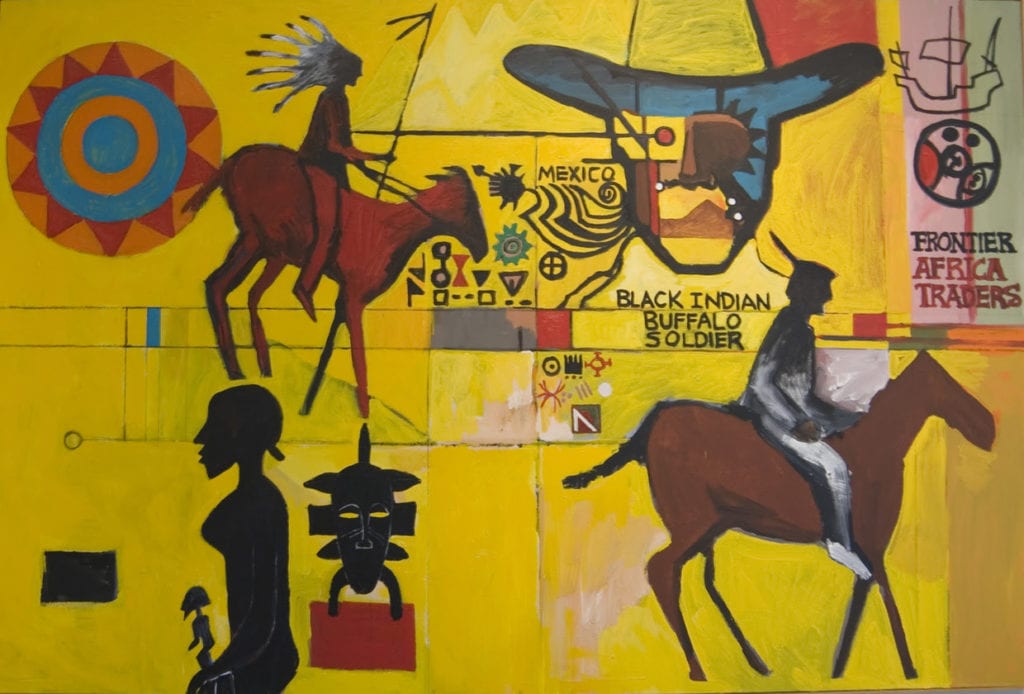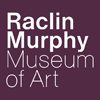Black Indian, Buffalo Soldiers

ABOUT THE ARTWORK
Who made it?

Chicago, IL painter and sculptor Bernard Williams creates works in multiple media that strive to “address our connections and disconnections within a turbulent human history” through the language of symbols and familiar imagery. Regarding his use of symbols and icons to tell stories, Williams has said that he’s “interested in trying to not fill in the whole story but suggest these relationships that are maybe contentious, that are these weighted relationships, and suggest the tension without delivering the whole story.”
Williams’ early career focused on large-scale outdoor murals throughout his hometown, the U.S., and abroad. He has gone on to work in sculpture (both large outdoor sculptures and smaller indoor pieces) and in painting. He finds inspiration in world history, archeology, comic books, and his hometown of Chicago.
Williams also frequently partners with young people to create collaborative artworks. In 2001, Williams was commissioned by the Raclin Murphy Museum to create a mural for the newly opened Robinson Community Learning Center. He worked with young people there to create a series of symbols exploring their reality and their hopes for the future. The murals have become so iconic to the Center and so beloved by the community, that they will be moved to the new building currently being constructed for the Center.
What’s going on in this work?

Williams is telling a story in this painting through the use of vibrant colors, symbols, and icons. The work is large and envelopes any viewer standing before it. It has a heavy, physical presence that rivals our own.
The story Williams is telling comes from American history but this history is not common knowledge.
The bold, glowing yellow background pulls us in and quite literally sets the scene as being somewhere different—in a landscape unlike that of the Midwest. Populating the mottled yellow field are human figures—Native and African Americans—engaged in various activities. The figures and the symbols surrounding them share the story of the Black Indian Buffalo Soldiers.
Williams intentionally includes borders, territories, and terrain to show how they merged two cultures. Written history often leaves out the role that African Americans play in the development of the West as we know it today. In fact, after the Civil War, the United States government created 6 peacetime military units consisting of all African American soldiers– Buffalo Soldiers–comprised of some Civil War veterans and newly freed slaves to secure the West by escorting wagon trains of Christian settlers and building forts, railroads, telegraph lines, and roads. At the end of their military service many soldiers settled in the West and became cowboys.
As with much of his work, in Black Indian, Buffalo Soldiers Williams “attempts to manage the overwhelming complexities of constructing histories that evoke radically differing worldviews. Time barriers are crossed, intersected, and allowed to coexist in a single work. The past is never over and always beginning, altering the model of history and creating the past anew.”
Take a closer look.

Click on the full image of Black Indian, Buffalo Soldiers above to see a larger version of the work. Look closely at the painting and use these questions to guide your looking. Share your thoughts with your family at home, with a friend through a virtual conversation, or with us in a response to this email.
- What’s going on in this picture? What do you see that makes you say that?
- What is a symbol? What symbols do you recognize in this painting? What do you think those symbols might mean?
- Who are the people that are part of this story? What are they doing?
- If you were going to illustrate a story about a historical event what symbols would you use?
To receive the collection in your inbox, join the Raclin Murphy Museum’s mailing list.

About the Article:
Engage with the Raclin Murphy Museum of Art by exploring their collection through background information and reflection questions. For more information on the collections, please visit the Raclin Murphy Museum of Art website.
Learn MoreApril 23, 2020


